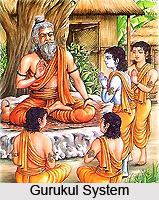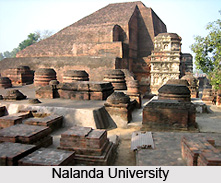 Education in ancient India had a deep impact in the upliftment and advancement of the early society and over all development. India is pregnant with a rich tradition of knowledge and learning from the earliest days of Indian civilization. There are several literary sources, such as the Vedas and other Hindu texts and scriptures, which offer references about education system of the ancient societies. The Mahabharata, some Dharma sutras, particularly those of Gautama Buddha and Apastamba and the Manu Smriti, are the principal works dealing with the system of education in ancient India.
Education in ancient India had a deep impact in the upliftment and advancement of the early society and over all development. India is pregnant with a rich tradition of knowledge and learning from the earliest days of Indian civilization. There are several literary sources, such as the Vedas and other Hindu texts and scriptures, which offer references about education system of the ancient societies. The Mahabharata, some Dharma sutras, particularly those of Gautama Buddha and Apastamba and the Manu Smriti, are the principal works dealing with the system of education in ancient India.History of Education in Ancient India
From the Vedic to the Brahman period, literature and additional literature sustained to be created. Even in the Brahman period, education continued to be looked upon as the means to knowledge. It has the same objectives that Vedic education had. However, with the passage of time and a change in the needs of society, the importance attached to them underwent a change. In this period, the following objectives were ascribed to education.
1. Self-control
2. Development of character
3. Generation of sociability or social awareness
4. Integral development of personality
5. Propagation of purity
6. Preservation of knowledge and culture.
Education in this age was unrelenting to carry on the foundations offered to it during the Vedic period, but a certain firmness and narrowness now marked its implementation. Education now aimed at equipping the student for the struggle for existence. After the "Upanayana" or introduction ceremony, teachers imparted education to their students according to the latter's interests, tendencies and nature. Celibacy was rigidly observed by the students. Teachers paid full attention to the psychological make-up of their students while teaching. Corporal or physical punishment was regarded as the last resort of administration and discipline. It has been stated in the Manu Smriti and Yajyavalka.
Gurukul System
Education in Ancient India originated with the Gurukul system. This type of ancient Hindu school in India was residential in nature with the Shishyas or students and the Guru or teacher living in proximity within the same house. The students resided together irrespective of their social standing. However, several temples and community centers regularly took the role of schools. In addition to that ancient Indian education achieved a noticeable position in the early Vedic period, beginning in the 1200 B.C. In the Vedic days, the teaching of the four Vedas, the hymns and ritual practices were seen.
 The Vedas included the Sanskrit language which in turn became the language of classical learning. Besides the pronunciation of the Vedas and their implication, phonology, metrics, elementary grammar, and etymology were also taught. Though, the Vedic education was not transmitted to people of low strata, yet the Vedic system inspired the modern day education system. The school in the ancient education system lasted for 7 to 8 hours a day. In fair weather; classes were held under the shelter of the tree. In the rainy season schools ran under thatched roof. Temple colleges of the past had been of great renown for having spacious buildings for classrooms and the residential complexes of the students and the "Gurus". Gurukuls and Ashrams were generally situated on the river banks or on the lake to attain the knowledge.
The Vedas included the Sanskrit language which in turn became the language of classical learning. Besides the pronunciation of the Vedas and their implication, phonology, metrics, elementary grammar, and etymology were also taught. Though, the Vedic education was not transmitted to people of low strata, yet the Vedic system inspired the modern day education system. The school in the ancient education system lasted for 7 to 8 hours a day. In fair weather; classes were held under the shelter of the tree. In the rainy season schools ran under thatched roof. Temple colleges of the past had been of great renown for having spacious buildings for classrooms and the residential complexes of the students and the "Gurus". Gurukuls and Ashrams were generally situated on the river banks or on the lake to attain the knowledge.For more, visit the link below: